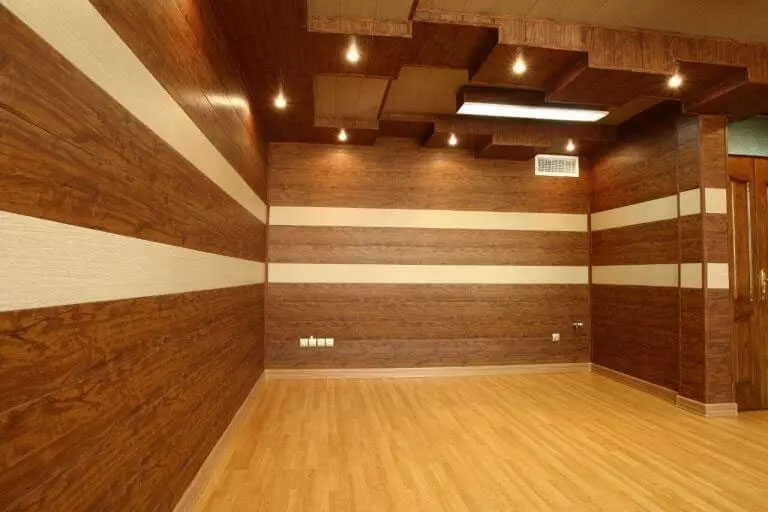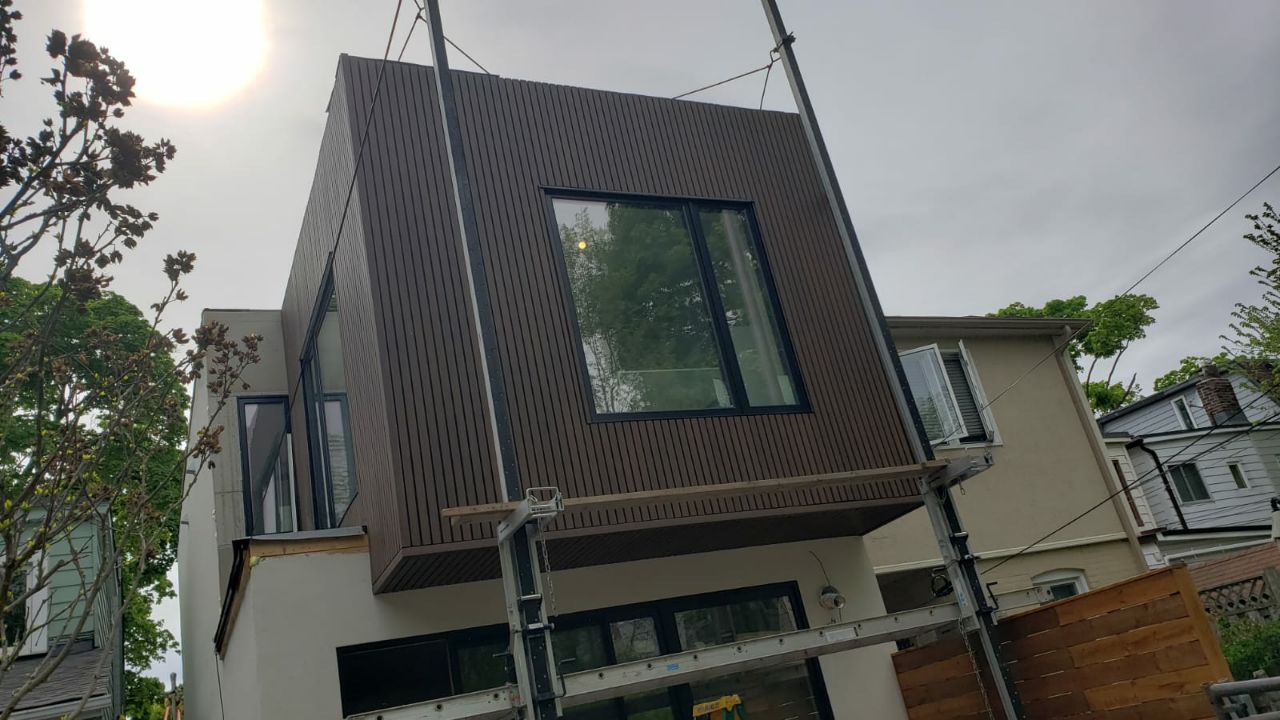Wood composite panels, also known as engineered wood or composite wood, are innovative construction materials that combine wood fibers or particles with adhesives and other additives to create a versatile and sustainable alternative to traditional wood products. These panels are composed of wood-based materials, such as particleboard, MDF (Medium-Density Fiberboard), or plywood, which are bonded together to form a strong and durable composite. The combination of wood components with adhesives results in a material that exhibits enhanced structural stability, resistance to warping, and a more uniform appearance compared to natural wood.
One of the significant advantages of wood composite panels is their sustainability. These panels often utilize recycled or recovered wood fibers, reducing the demand for virgin timber and minimizing waste. Additionally, the manufacturing process typically involves using less energy compared to the production of traditional wood products, making wood composites an environmentally friendly option for construction and furniture applications. The use of adhesives in the composite process also allows for the utilization of wood particles that may not be suitable for solid wood products, reducing overall material waste.
Wood composite panels offer a high level of versatility in terms of design and application. They can be engineered to have specific properties, such as increased strength, moisture resistance, or fire retardancy, making them suitable for a wide range of uses in both residential and commercial construction. The smooth and consistent surface of wood composites makes them ideal for applications such as cabinetry, furniture, wall paneling, and flooring, where a uniform appearance is desired.
These panels are known for their dimensional stability, meaning they are less prone to expansion, contraction, or warping due to changes in humidity or temperature. This characteristic makes wood composite panels a reliable choice for applications where traditional wood might be susceptible to environmental factors. Moreover, the consistent quality of these panels allows for easier installation and a more predictable outcome in construction projects.
Advantage of wood composite panels
Wood composite panels offer several advantages, making them a popular choice in various construction and design applications:
Sustainability
Wood composite panels are considered a sustainable building material due to several key factors that contribute to environmental responsibility. First and foremost, these panels often utilize recycled or recovered wood fibers as a primary component. By incorporating wood particles from post-industrial or post-consumer sources, composite panels help reduce the demand for virgin timber, promoting resource conservation and minimizing the environmental impact associated with logging.
Additionally, the manufacturing process of wood composite panels typically requires less energy compared to traditional wood products. The use of recycled wood fibers and the efficient bonding process contribute to lower energy consumption, reducing the carbon footprint associated with production. This aligns with sustainable practices by minimizing energy-related environmental effects and promoting more efficient use of resources.
Furthermore, wood composite panels contribute to waste reduction in the construction industry. By utilizing wood particles that might otherwise be considered waste or byproducts, these panels help divert materials from landfills. This approach aligns with the principles of the circular economy, where materials are recycled or repurposed to extend their lifespan and reduce the overall environmental impact of construction projects. Overall, the sustainability of wood composite panels stems from their use of recycled materials, energy-efficient manufacturing processes, and their role in minimizing waste within the construction industry.
Uniform Appearance
The uniform appearance of wood composite panels is a distinctive feature that sets them apart from natural wood products. Unlike solid wood, which may exhibit variations in color, grain patterns, and texture, wood composite panels offer a consistent and smooth surface. This uniformity is achieved through the manufacturing process, where wood fibers or particles are blended with adhesives and other additives. The result is a panel with a predictable and homogeneous appearance, making it an ideal choice for applications where a cohesive and flawless look is desired.
The consistent appearance of wood composite panels contributes to design flexibility and aesthetic appeal. Designers and architects often appreciate the predictability of these panels, allowing for precise planning and execution of projects. Whether used in furniture, cabinetry, flooring, or wall paneling, the uniform surface of wood composites provides a sleek and modern look that aligns well with contemporary design trends. This characteristic makes them suitable for both residential and commercial spaces where a cohesive and sophisticated appearance is desired.

In addition to aesthetic considerations, the uniform appearance of wood composite panels simplifies the installation process. Unlike natural wood, where matching grain patterns or colors can be a meticulous task, composite panels ensure a consistent look without the need for sorting or careful arrangement during installation. This ease of installation can save time and effort for contractors, making wood composite panels a practical choice for various construction and design projects.
Furthermore, the uniformity of wood composite panels contributes to their durability and long-term aesthetic appeal. The absence of natural variations reduces the likelihood of visible aging or wear over time. This quality makes composite panels a reliable choice for applications where maintaining a fresh and contemporary appearance is essential, providing a lasting solution for residential, commercial, and industrial design projects.
Dimensional Stability
Wood composite panels are renowned for their high dimensional stability, a characteristic that sets them apart from natural wood products. Dimensional stability refers to a material’s resistance to changes in size or shape due to environmental factors such as humidity, temperature fluctuations, or exposure to moisture. The composition of wood composite panels, typically a mixture of wood fibers or particles combined with adhesives and other additives, results in a material that is less prone to expansion, contraction, or warping compared to solid wood.
This enhanced dimensional stability makes wood composite panels a reliable choice for various applications where exposure to environmental conditions is a concern. In areas with fluctuating humidity levels or temperature extremes, such as bathrooms, kitchens, or outdoor installations, the panels maintain their shape and structural integrity over time. This characteristic is particularly beneficial for applications like flooring or wall paneling, where maintaining a consistent and level surface is essential for both aesthetic and functional reasons.
The reduced susceptibility to warping or changes in size also simplifies the installation process of wood composite panels. Contractors and installers can have greater confidence in achieving a precise and uniform result, as the panels are less likely to deform or shift after installation. This feature contributes to the overall durability and longevity of the panels, ensuring a stable and reliable material choice for construction and design projects that demand consistency and resilience in the face of environmental challenges.
Cost-Effective
Wood composite panels offer a cost-effective solution for various construction and design applications, making them an attractive choice for budget-conscious projects. One key factor contributing to their cost-effectiveness is the manufacturing process. Composite panels often use wood particles or fibers that may not be suitable for solid wood products, allowing for the utilization of a broader range of raw materials. This reduces material waste and can lead to lower production costs, making wood composite panels more economical than some traditional wood options.
The installation of wood composite panels is typically more straightforward compared to certain solid wood products. The uniformity of these panels ensures a predictable and consistent surface, simplifying the installation process for contractors. This can result in reduced labor costs, as the panels may not require the same level of precision and sorting during installation as natural wood. The ease of installation can contribute to overall project cost savings.
In terms of long-term costs, wood composite panels often prove to be more durable and resistant to factors like moisture, pests, and decay compared to natural wood. This durability reduces the need for frequent maintenance, repairs, or replacements, which can be significant cost-saving considerations over the life of a project. Homeowners and property managers may appreciate the lower long-term maintenance costs associated with wood composite panels.
Additionally, the cost-effectiveness of wood composite panels is reflected in their versatility. These panels can be engineered to possess specific properties, such as increased strength, moisture resistance, or fire retardancy, depending on the application. This adaptability ensures that the panels can be tailored to meet the requirements of various projects, providing a cost-effective solution that aligns with specific design and performance needs. Overall, the combination of manufacturing efficiency, ease of installation, durability, and versatility makes wood composite panels a cost-effective choice for a wide range of construction and design applications.
Resistance to Decay and Insects
Wood composite panels can exhibit enhanced resistance to decay, a quality that significantly contributes to their longevity and durability. The resistance to decay is achieved through the combination of wood particles or fibers with adhesives and other additives during the manufacturing process. The composition of these panels makes it possible to create a material that is inherently less susceptible to fungal decay compared to natural wood. This is particularly advantageous in applications where exposure to moisture or humid conditions is a concern, such as outdoor decking, siding, or other exterior applications.
The resistance to decay in wood composite panels is further augmented by the absence of natural defects and vulnerabilities that may exist in solid wood. Traditional wood is prone to deterioration when exposed to moisture, insects, or fungal growth. In contrast, composite panels, being a synthetic material, can be engineered to resist these elements effectively. This characteristic makes them suitable for outdoor installations where protection against decay is crucial for maintaining structural integrity and aesthetic appeal over time.
The increased resistance to decay not only ensures the structural soundness of wood composite panels but also reduces the need for chemical treatments or preservatives that are commonly applied to natural wood products. This aligns with environmental considerations, as it minimizes the use of potentially harmful substances and contributes to the sustainability of the panels. Overall, the improved resistance to decay is a key advantage of wood composite panels, making them a reliable and durable choice for applications in both indoor and outdoor settings.
In conclusion, wood composite panels offer a sustainable, versatile, and dimensionally stable alternative to traditional wood products. Their environmentally friendly nature, adaptability to various designs and applications, and enhanced structural properties make them a preferred choice in the construction and furniture industries, providing a balance between aesthetic appeal and functional performance.


